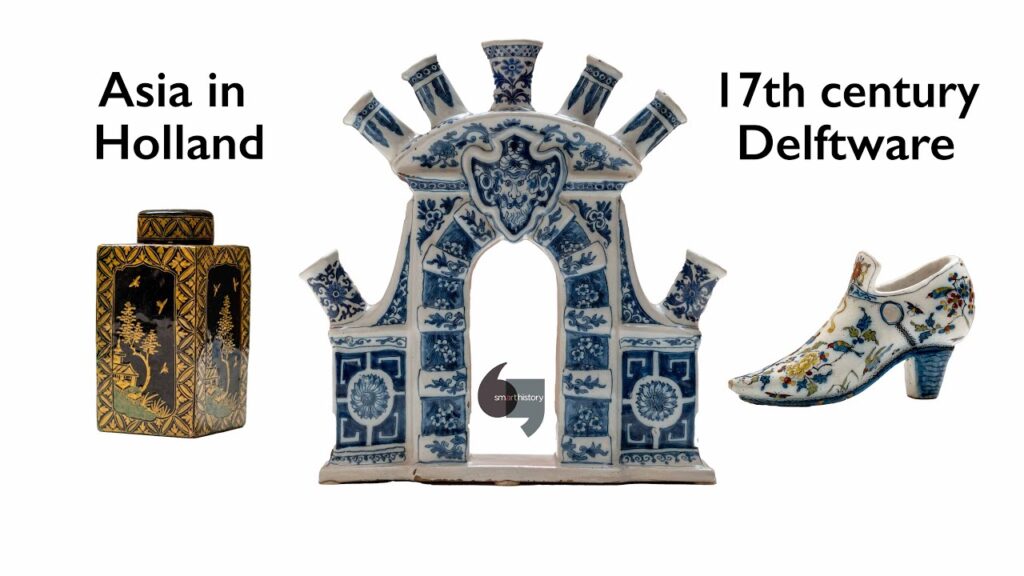Adriaen Kocks, proprietor, The Greek A Factory (attributed), one of a pair of tulip vases as triumphal arches, c. 1690–1705, tin-glazed earthenware, 29.5 x 30.5 x 7.6 cm (Museum of Fine Arts, Boston)
Lambertus van Eenhoorn, proprietor, De Metaalen Pot Factory (attributed), Tea canister, c. 1695–1720, lacquer imitation black glaze, tin-glazed earthenware, 14 cm high (Museum of Fine Arts, Boston)
Jacob Wemmersz Hoppesteijn, proprietor, Het Moriaenshooft factory (attributed), Miniature shoe, c. 1685, tin-glazed earthenware, polychrome enamel decoration, 10.5 x 18 cm (Museum of Fine Arts, Boston)
speakers: Courtney Harris, Assistant Curator, Decorative Arts and Sculpture, Museum of Fine Arts, Boston and Steven Zucker


gracias por tanto, Saludos from Bolivia
Exquisite! The video and the art itself.
Fantastic video! I love that arch
Love English slipware & tin glaze 😊
Copies. Nice, but copies. In China the real thing.
The rarity of the Dutch pieces exceeds by far that of Chinese porcelain which is now abundant.
No. Culture influenced by other culture isn’t a copy; it is its own *new* thing… and ALL culture (unless it is completely isolated) is influenced by other culture. Chinese culture has adapted ideas from other cultures as much as any other culture, and so have the Dutch.
This was well done, like everything smart history puts out. 👏👏👏
I’ve always loved the colors blue and white together, and love Delftware. I have a few pieces of Delftware, but my dishes are all store-bought Blue Willow. I’d love to know more about the history of that design, as well as what I’ve heard of the technique referred to as ‘Flow Blue’.
@Ronique Breaux Jordan Thank you. 🙂
Hello, I love the blue willow pattern too and I have a set of ware in it. I was calling ware ‘delph’. In Ireland, in the past more so, delph was what earthenware kitchen dishes were called. I’m 48 and recall my grandmother, in the 1980s, using that word. I wonder was modern blue willow design, copied from China or Japan? God bless and happy New Year from Ireland xx 5th of January 2022.
@Mathona Moore I’m afraid I know so little about it – I started falling in love with Blue Willow when I was a child. I read a book of the same name about a little girl during the Great Depression who only has one thing of beauty – a Blue Willow plate that had belonged to her late mother. It was a charming book, and it got me started on the pattern. And, God bless, and Happy New Year to you, from the Ozarks. 🙂
@Curious World hello, thank you for your reply. I have this well to do aunt and she has many cabinets of antique china delph but also lots of blue willow items. I remember, as a child, thinking some day ill have these dishes in my kitchen lol I finally bought a dinner set, in my late 20s but it was just slightly over average price of a 6 piece dinner set. Ideally, I’d only have all that design but I don’t think it’s practical, to get rid of other delph, it’s perfect lol Happy New Year from Ireland xx
@Mathona Moore Hi! I have to admit, my Blue Willow is all store-bought, and not terribly expensive. But, I love it. 🙂 How lucky for you, though! Happy New Year from the Ozarks. 🙂
Thank you for sharing these amazing and beautiful art pieces
Thank you for this time and geographical line of how Delft porcelain came to be…
One of the fascinating things about authentic Delft ware is the fact that the glaze does not craze with age. Something that is common with porcelain or stoneware but not so much with ceramics fired at lower temperatures.
so much historical information in six minutes..
This shoe!!!